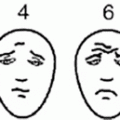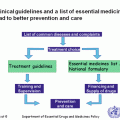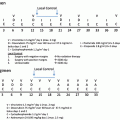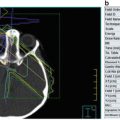Cancer cachexia
Multifactorial
• Disease
• Host
• Socio-economic
• Treatment
Interactive tumour and host-related effects
• Socio-economic, inadequate supply of nutrients
• Anorexia
• Bowel obstruction
• Malabsorption
• Pain
• Metastatic disease
• Metabolic effects (Paraneoplastic)
• Altered metabolism of protein, fat and carbohydrate
• Increased resting energy expenditure (REE)
Therapy related effects
• Multimodal treatments (chemotherapy, radiation and surgery)
• GI: nausea and vomiting, mucositis, impaired digestion, diarrhoea, ileus, morphological changes to gut mucosa, decrease appetite
• Infection and antibiotics
• Other drugs
• Other organ toxicities
CNS/psychosocial
• Anorexia
• Food aversion
• Anticipatory vomiting
• Depression/anxiety
• Body image
• Loss of control by the patient of their environment
• Parental influence and perceptions
• Changes in taste and smell
At the other end of the malnutrition spectrum is obesity. Obesity has been shown to be related to increased toxicity of treatment in acute myeloblastic leukaemia and an increase relapse rate in acute lymphoblastic leukaemia [11–13]. It has been documented that undernutrition, overweight and obesity are associated with a change in pharmacokinetics of drugs as seen in Table 8.2, which may result in inappropriate dosing by either inadequate- or overdosing [14–17]. For example, drugs such as Methotrexate have delayed clearance in the underweight patient, especially when high doses are being utilised, this may result in prolonged toxicity such as mucositis or renal damage [17].
Table 8.2
Alterations of drug disposition in severely underweight patients
Absorption | Decreased rate and possibly extent of absorption |
Distribution | Decreased serum proteins (albumin an α-1 acid glycoprotein) • May increase free active drug, but may increase clearance of some drugs |
Metabolism | Reduced oxidative and conjunctive reactions • Decreases terminal clearance of metabolised drugs, but may also increase oral absorption of drugs with extensive presystemic metabolism in the gut or liver |
Renal excretion | Glomerular filtration rate and possibly tubular secretion are reduced |
Not only does decreased protein and/or energy intake result in increased morbidity of cancer but also deficiency of micronutrients (both vitamins and trace elements) can exacerbate the co-morbidities associated with cancer and its treatment [18, 19]. Some of the co-morbidities related to vitamin and trace element deficiency are listed in Table 8.3.
Table 8.3
Clinical findings associated with nutritional inadequacies
Area of examination | Findings | Considered nutritional inadequacy |
|---|---|---|
General | Underweight; short stature | ↓Calories |
Oedematous; decreased activity level | ↓Protein | |
Overweight | ↓Calories | |
Hair | Ease of pluckability; sparse, depigmented; lack of curl; dull, altered texture; flag sign | ↓Protein |
Skin (general) | Xerosis, follicular keratosis | ↓Vitamin A |
Symmetric dermatitis of skin exposed to sunlight, pressure, trauma | ↓Niacin | |
Oedema | ↓Protein | |
Petechiae, purpura | ↓Ascorbic acid | |
Scrotal, vulval dermatitis | ↓Riboflavin | |
Generalised dermatitis | ↓Zinc, essential fatty acids | |
Erythematous rash around mouth and perianal area | ↓Zinc | |
Skin (face) | Seborrheic dermatitis in nasolabial folds | ↓Riboflavin |
Moon face; diffuse depigmentation | ↓Protein | |
Subcutaneous tissue | Decreased | ↓Calories |
Increased | ↓Calories | |
Nails | Spoon-shaped; koilonychia | ↓Iron |
Eyes | Dry conjunctiva; keratomalacia; Bitot’s spots | ↓Vitamin A |
Circumcorneal injection | ↓Riboflavin | |
Lips | Angular stomatitis | ↓Riboflavin, Iron |
Cheilosis | ↓B-complex vitamins | |
Gums | Swollen, bleeding | ↓Vitamin C |
Reddened gingiva | ↓Vitamin A | |
Teeth | Caries | ↓Fluoride |
Stained teeth | ↓Iron supplements | |
Mottled, pitted enamel | ↓Fluoride | |
Hypoplastic enamel | ↓Vitamins A, D | |
Tongue | Glossitis | ↓Niacin, folate, riboflavin, vitamin B12 |
Skeletal | Costochondral beading | ↓Vitamins C, D |
Craniotabes; frontal bossing; epiphyseal enlargement | ↓Vitamin D | |
Bone tenderness | ↓Vitamin C | |
Muscles | Decreased muscle mass | ↓Protein, calories |
Tender calves | ↓Thiamin | |
Neurologic | Ophthalmoplegia | ↓Thiamin, Vitamin E |
Hyporeflexia | ↓Vitamin E | |
Ataxia, sensory loss | ↓Vitamins B12, E | |
Endocrine and other | Hypothyroidism | ↓Iodine |
Glucose intolerance | ↓Chromium | |
Altered taste | ↓Zinc | |
Delayed wound healing | ↓Vitamin C, zinc |
Increased Risk of Infection
It has been well documented in children without cancer that undernutrition will result in increased risk of variety of infections [7–9, 20, 21]. These infections themselves can exacerbate the malnourished state in the cancer patient and is most apparent in infections such as tuberculosis or HIV. The presence of parasitic disease is ubiquitous, especially in African countries, and will also add to the degree of undernutrition. Bacterial and viral infections are frequent occurrences during treatment of patients with cancer. The inability to ward off such infections during treatment is impaired by the presence of undernutrition [1, 7, 20].
Chronic diarrhoea, due to a multitude of causes, is a frequent problem in developing countries. In countries such as Bangladesh, chronic diarrhoea patients are often zinc depleted and zinc substitution benefits these patients [22].
An important aspect that needs reiterating is the need to maintain or improve the quality of life for our patients that we treat for cancer, the sense of well-being is definitely improved in those children who are receiving adequate nutrition [2, 7, 9, 23]. Published studies in LIC have shown that malnutrition at cancer diagnosis could cause delays in cancer treatment, poor adherence to treatment and a negative impact on outcome [24].
Co-morbidities which are a result of malnutrition or result in malnutrition do need to be evaluated clinically [25]. These include the presence of infection, both chronic and acute, as well as organ dysfunction that may have resulted from infections and/or malnutrition. The lists of these co-morbidities relevant to poor nutrition are listed in Table 8.4.
Table 8.4
Short- and long-term consequences of malnutrition on the paediatric cancer survivor
Short-term consequences | Long-term consequences |
|---|---|
Wasting of muscle- and fat mass | Growth impairment, reduced final height |
Decreased tolerance of chemotherapy | Decreased long-term survival in several tumour types |
Unfavourable response to chemotherapy | |
Treatment delays | Impact on motor, cognitive and neurodevelopmental impairment |
Fatigue | |
Biochemical disturbances (anaemia and hypoalbuminemia) | Risk for metabolic syndrome |
Risk for secondary cancers | |
Risk for ageing | |
Delayed recovery of normal marrow function | Increased mortality rate |
Changes in body composition | Retardation of skeletal maturation |
Drug dose alteration | Abnormal bone mineral density |
Decreased quality and productivity of life | Decreased quality of life |
Greater levels of psychological distress | |
Higher susceptibility to infections |
Nutritional Assessment
There are many textbooks and review articles on nutritional assessment and nutritional requirements for paediatric patients which are relevant to children with cancer and are available for further background on the following guidelines in this chapter [10, 26–30].
Nutritional assessment of Paediatric Oncology patient’s should commence at diagnosis, continue whilst on therapy as well as during survivorship. The A, B, C, D’s of nutrition assessment consists of anthropometry-, biochemical-, clinical- and dietary assessment. Anthropometric measurements are tabulated in Table 8.5, biochemical indicators in Table 8.6 and current clinical examination as in Table 8.3. Nutritional assessment is required to identify nutrition-related health status and help in decision making for the appropriate nutritional interventions.
Table 8.5
Important anthropometric measurements and assessments in children
• Weight (Wt) |
• Height/length (Ht) |
• Head circumference (<3 years) |
• Weight for height/length |
• Ideal body weight (IBW = patients actual Wt divided by the ideal Wt for Ht × 100) |
• Body mass index (BMI = Wt in kg divided by Ht in metres squared) |
• Height and weight Z-score |
• Triceps skin fold (fat stores) |
• Arm circumference (muscle stores) |
• Waist circumference |
• Height velocity |
Table 8.6
Parameters part of biochemical assessment in high income countries
• Complete blood count, hepatic biochemistry, renal and fluid biochemistry, sugar |
Albumin (half-life 14–21 days) |
Transferrin (half-life 8–9 days) |
Pre-albumin (half-life 2–3 days) |
Retinol binding protein (half-life 12 h) |
• Fat status |
Cholesterol |
Lipoproteins |
• Trace elements: Zn, Cu, Se, Mg |
• Vitamins: A, C, E, Thiamine, Riboflavin |
• Global biochemical assessment of antioxidants |
Anthropometry Evaluation [26, 27]
The weight and height of the patient needs to be plotted on relevant WHO growth charts or compared with WHO data tables for age and gender. The corresponding Z-scores must then be categorised according to Table 8.7 to determine nutritional status.
Table 8.7
Summary of categories for Z-scores to determine nutritional status according to WHO standards
Z-score | H/A | W/H | W/A | BMI/A |
|---|---|---|---|---|
> +3 SD | Above normal | Obese | Possible growth problem | Obese |
>+2 to +3 | Normal height | Overweight | Possible growth problem | Overweight |
−1 to ≤+2 | Normal height | Possible risk of overweight | Possible growth problem | Possible risk of overweight |
<−1 to ≥−2 | Normal height | Normal weight | Normal weight | Normal weight |
<−2 to ≥−3 | Stunted | Wasted | Underweight | Wasted |
<−3 SD | Severely stunted | Severely wasted | Severely underweight | Severely wasted |
Stunting (low H/A) reflects on a child’s length or height and is associated with chronic malnutrition or long-term growth faltering, insufficient food intake and frequently associated with low socio-economic status.
Underweight (low W/A) is when a child weighs less than the corresponding age- and gender group.
Wasting (low W/H) is an indicator of acute or recent malnutrition. It is a measure of how skinny a child is when compared to the corresponding height.
Body mass index for age (BMI/A) is determined by the following: weight (kg)/length (m 2 ). BMI growth charts are available from birth but are more appropriate for children older than 2 years of age. Low BMI is an indicator of wasting while BMI above the 85th percentile (+2 Z-score) indicates overweight and above the 95th percentile (+3 Z-score) indicates obesity.
Head circumference should be plotted on growth charts and compared with previous readings. This should be done especially for children under the age of 2 years.
Triceps skin fold (TSF) is measured by skin fold callipers.
Mid upper arm circumference (MUAC) is measured by reference tape at the position of the mid upper arm.
The TSF and MUAC values must be evaluated according to age and gender reference values as on WHO charts or data tables and then categorised as seen in Table 8.8 to determine body stores. It is the preference that TSF and MUAC be undertaken by one consistent observer as these measurements will vary if they are taken by different observers.
Table 8.8
Categories of Z-scores and percentiles to determine fat and muscle stores according to WHO standards
Z-score | Percentile | TSF/AFA/MUAC |
|---|---|---|
> +3 SD | ≥97th | Excess |
> +2 to +3 | ≥85 to <97th | Above average stores |
<+2 to <−1 | ≥15 to <85th | Average stores |
<−2 to ≥−3 | ≥3 to <15th | Below average stores |
<− 3 SD | <3rd | Depleted stores |
It is recommended that patient’s anthropometric measurements be done on a regular basis and longitudinal. Guidelines for the time frames of these measurements are presented in Table 8.9.
Table 8.9
Minimum guideline for assessing anthropometric data
Parameter | Diagnosis | Each subsequent in-patient admission | Out-patient clinic review | At least every 4 weeks |
|---|---|---|---|---|
Weight | ✓ | ✓ | ✓ | |
Height | ✓ | ✓ | ||
Plot on centile chart/BMI chart | ✓ | ✓ | ||
Body mass index/%weight:height | ✓ | ✓ | ✓ | |
% Weight loss since diagnosis | ✓ | ✓ | ||
Mid upper arm circumference | ✓ | ✓ |
Anthropometry of PEM [26, 27, 30]
Z-score of <−2 SD below the reference median for all measurements is an indicator of severe malnutrition
Decrease in percentile for weight/height or two major percentiles
Height for age (H/A) <95 % of the median for gender and age
H/A <75 % an indicator of chronic malnutrition
H/A <5th percentile indicates chronic undernutrition
Weight for height (W/H) under 90 % of the median for gender and age
W/H <50th percentile
W/H <10th percentile indicates severe wasting
Weight loss >5 % to pre-illness weight or in 1 month
BMI <10th percentile for age and gender
TSF <5th percentile for age and gender
AFA <5th percentile for age and gender
AMA <5th percentile for age and gender
MUAC <5th percentile for age and gender
PEM can also be seen by a single measurement, such as MUAC, where a low value in paediatric patients classify them as acute malnourished:
<12.5 cm if <5 years
<13.5 cm if >5 years of age
In Table 8.10 values are presented to determine differences in severe malnutrition in children with cancer
Table 8.10
Assessment of nutritional status—cut-offs
Age group
Acute malnutrition
Severe acute malnutrition
6 months to 5 years
MUAC <125 mm
MUAC <110 mm
>5 years without tumour massa
Weight for height <−2 SD
Weight for height <−3 SD
>5 years with a tumour massb
MUAC <135 mmc
MUAC <115 mmc
Biochemical Assessment for PEM [26, 27]
Serum albumin under 3.2 mg/dL (if no acute metabolic stress previous 2 weeks) may be seen as an indicator of a patient’s protein status. Careful interpretation of low serum albumin values are needed, because other non-dietary factors are often the cause for decreased values. Serum albumin half-life is approximately 2 weeks and and need to be used in conjunction with other parameters for nutritional status.
Pre-albumin, when available, can also be used which has a half-life of only 2 days and therefore a better indicator of acute change of protein status.
Clinical Assessment of PEM Is Seen as [26, 27]
Loss of subcutaneous fat.
Presence of muscle wasting.
Resent weight change (weight loss or-gain must not be related to fluid retention or loss of fluid).
Presence of oedema at ankles, sacrum or face.
Hair changes.
Conditions that may affect the nutritional status, e.g.: inability to chew and swallow; loss of appetite; the presence of vomiting, diarrhoea, constipation, flatulence, belching or indigestion.
Signs or symptoms suggestive of vitamin and/or mineral deficiencies. (As seen in Table 8.3).
Medications and their nutrient interactions.
Gut dysfunction for longer than 5 days in well-nourished patients.
Dietary Assessment of PEM Is Seen as [26, 27]
Food intake of less than 70 % of a patient’s requirements for 5 days.
Table 8.11 indicates cancer patients at high risk for PEM.
Table 8.11
Patients at high risk for malnutrition
• Patients with advanced disease, e.g. metastatic |
• Malnutrition or evidence of cachexia present at diagnosis |
• Patients expected to receive highly emetogenic regimens |
• Patients treated with regimens associated with severe gastrointestinal complications such as constipation, diarrhoea, loss of appetite, mucositis, enterocolitis |
• Patients with relapse disease |
• Patients who are <2 months old |
• Patients who are expected to receive radiation to oropharynx/oesophagus or abdomen |
• Chemotherapy treatment protocol with high occurrence of gastrointestinal or appetite depressing side effects such as Burkitt’s Lymphoma, Osteogenic sarcoma and CNS tumours |
• Post-surgical gastrointestinal complications such as prolonged illness or short gut syndrome |
• Patients receiving a stem cell transplant |
• Inadequate availability of nutrients due to low socio-economic status |
• Patients with behavioural or eating disorder |
Nutritional Requirements of Children with Cancer [26, 30–34]
Energy Requirements
The resting energy expenditure (REE) and nutrient requirements should be defined for each cancer patient when possible. The recommended daily allowance (RDA) for energy requirements of healthy children is seen in Table 8.12. An appropriate activity factor (AF) as seen in Table 8.13 can be factored. This is required to compensate for the increased demands on the body due to the tumour and other co-morbidities. Factors such as fever, infection, stress, physical activity and catecholamine can elevate energy expenditure [30]. For example, a 4-year-old girl is admitted in the unit, she weighs 12 kg. RDA is 90 kcal, so 12 kg × 90 kcal = 1080 kcal × 1.5 AF = 1575 kcal/day.
Table 8.12
Recommended daily allowances for calories and protein for children
Category | Age (years) | Protein (g/kg/day) | Calories (kcal/kg/day) |
|---|---|---|---|
Infant | 0.0–0.5 | 2.2 | 108 |
0.5–1.0 | 1.6 | 98 | |
Child | 1–3 | 1.2 | 102 |
4–6 | 1.1 | 90 | |
7–10 | 1.0 | 70 | |
Male | 11–14 | 1.0 | 55 |
15–18 | 0.9 | 45 | |
Female
Stay updated, free articles. Join our Telegram channel
Full access? Get Clinical Tree
 Get Clinical Tree app for offline access
Get Clinical Tree app for offline access

|




